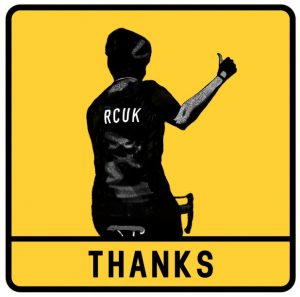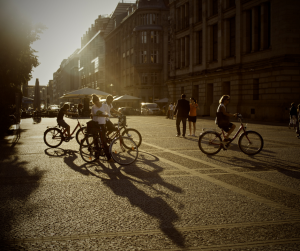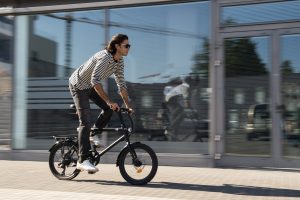More and more people are challenging the car-dominated culture of our cities. And why not? Urban cycling is fun, healthy, and lets you see your town in a new and exciting way. A bike can get you to the grocery store, concerts, school, or work—you name it.

Biking through a city scares a lot of people. Urban cycling sounds terrifying, but it’s not as complicated or dangerous as it seems. Riding safely in traffic can be distilled down to three key behaviors:
Be visible: Wear a bright jacket/top or white helmet. Equip your bike with front and rear flashing safety lights, and use them at night and in gloomy daylight conditions. For extra visibility, add spoke lights.
Be legal: To earn respect, show respect to other road users. Ride with traffic, not against it. Use bike lanes where available. Observe the road rules. Ride in single file. Ride on the street or in a bike lane, not on the sidewalk unless this is permitted. The sidewalk may feel safer, but you must stay alert for pedestrians and driveway traffic.
Be predictable: Don’t ride erratically or weave in and out of cars. Hand signal your turning intention before you enter the turn. Be courteous to other road users by not needlessly blocking lanes or impeding traffic flow, unless the safest action is to “take a lane.” When riding with family or friends, focus on the traffic, not the chat.

-
Know Your State’s Laws
Do you need to wear a helmet in your state? Are you allowed to ride on sidewalks? Is it legally safe to pass a car on the left side when you’re on a bike? Like driving, every state has a different set of laws for cyclists, so it’s worth brushing up on the basics.
Give a look at this article to know the essential road cycling hand signals.

-
Assume car doors will open
Getting doored is a shockingly common occurrence. Sadly, the only way to truly prevent this from happening is to keep a good distance between yourself and parked cars.
And watch for movements inside those parked cars that suggest someone inside is about to open a door without looking.
-
Look where you want to go
Don’t spend too much time worrying about the traffic behind you. The majority of bike accidents involving cars happen when the driver and rider cross each other’s path at intersections and driveways, especially when a driver turns in front of a rider.
-
If you can’t see their mirrors…
…then they can’t see you. Simple as that.
-
Don’t box yourself in or tailgate vehicles
Try not to ride into a situation where you don’t have a clear exit. A good example of this is when you are approaching a red light, riding between rows of stationary or slow-moving traffic.
Don’t get trapped between vehicles as many drivers won’t see you if you’re sitting right next to them when the lights turn green.
Similarly, the stopping distance of other road users will usually be significantly better than yours, so always keep a sensible distance from the vehicle ahead.
-
Hold your line
To stay safe in traffic, you need to keep track of what’s happening behind you, so it’s a good idea to master the skill of looking behind you without swerving. Practice riding on the painted line of a quiet road or parking lot. Once you can do this, try maintaining your course while turning your head to the left. Slightly drop your left shoulder while keeping your right shoulder level. Don’t rely on peripheral vision. You should be able to turn your head far enough to see clearly behind you.
If you’re struggling, try sticking out your left arm straight behind you, then turn your head, shoulders, and neck as you look over your left shoulder. Sighting down your arm will help you keep riding straight. Eventually, you’ll be able to do it without using your arm as a guide.
-
Follow the flow
When riding in a standard road lane, ride on the right, but not too far right. Yes, this puts you closer to the flow of traffic, but it’s also safer because drivers will be less tempted to try to squeeze past you.
Not hugging the gutter also reduces your risk of getting walloped when someone opens the door of a parked car.
Claim the entire lane, if that’s what you need to ensure safety. In fact, on some streets that feature special bike lane markings (known as sharrows) cyclists are supposed to take the entire lane. Taking the full lane is often the safest way to ride downhill sections where the speed limit is 30 miles per hour or less because a bike can easily keep up with other vehicles. In this case, it’s better to just act like a car.
-
Use Google Maps
Google Maps has cycling directions, and they’re fantastic. If you don’t know how to get around, plot out your route in Google Maps first. This will guide you along bike-friendly streets and paths so you can avoid accidentally getting on some four-lane road with no room on the side.
Heck, you can even break the no headphone rule and get turn-by-turn directions if you need to (but seriously don’t also listen to music or podcasts or whatever).
-
Ride for yourself
It’s easy for a beginner to go out and simply follow other riders in traffic but we’d strongly advise against doing this. Chances are the decisions they’re making will not be considering your safety, and there’s no guarantee that the person you are following is a good rider anyway.
Ride for yourself. Have your own cycling ability and safety in mind when riding in traffic.
Well, that should cover the basics pretty well. Have you ever been in a bike
accident? How did it happen? If you have any other tips to share please leave a
comment below 🙂






A lot of great cycling tips, thanks Linky.
Thank you Roger for reading 🙂